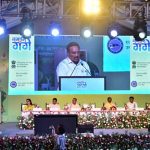The meeting reaffirms the government’s commitment to making the river cleaner and more sustainable through an integrated and technology-driven approach
New Delhi, Mar 12 Union Minister of Jal Shakti C.R. Patil chairs the 14th meeting of the Empowered Task Force (ETF) on Ganga conservation, reaffirming the government’s commitment to making the river cleaner and more sustainable through an integrated and technology-driven approach.
Highlighting his vision for a rejuvenated Ganga, he emphasized the need for time-bound execution of projects, strict pollution control measures, and enhanced inter-ministerial coordination. He stressed the importance of leveraging geospatial technology, real-time monitoring systems, and innovative conservation strategies to achieve long-term sustainability.
He also reiterated the government’s resolve to balance development with ecological preservation, ensuring that river conservation efforts support livelihoods, biodiversity, and cultural heritage. The meeting brought together key stakeholders from various ministries and state governments, including Union Minister of State for Jal Shakti Raj Bhushan Chaudhary.
The Union Minister reviewed the progress of 492 projects under the Namami Gange Mission, with a total outlay of ₹40,121 crore across 10 states, and highlighted the mission’s significant strides in rejuvenating the river and enhancing its ecological health. He noted that 307 projects worth ₹19,478 crore have been completed, marking a significant milestone in improving water quality and pollution control.
The Minister gave special attention to the development of sewage treatment infrastructure, highlighting that 3,346 MLD of sewage treatment capacity has been created and a 4,543 km sewerage network has been completed to prevent the discharge of untreated wastewater into the river. He stressed that these efforts are pivotal in strengthening pollution control mechanisms and ensuring long-term sustainability of the Ganga’s ecosystem.
The Minister closely reviewed the compliance with Environmental Flow (e-Flow) norms, as mandated by the 2018 Gazette Notification, underscoring the government’s commitment to maintaining the ecological integrity of the Ganga.
The Minister conducted a comprehensive review of efforts to curb industrial pollution under the Namami Gange Mission, emphasizing the government’s unwavering commitment to a pollution-free Ganga. The meeting highlighted the results of the seventh round of inspections, which covered 4,246 Grossly Polluting Industries (GPIs) across the Ganga Basin.
A key highlight of the meeting was the inauguration of the GIS Layer & Dashboard by Union Minister Jal Shakti, marking a significant milestone in data-driven conservation efforts. This advanced platform will serve as a foundation for scientific and real-time monitoring of wetlands, integrating wetland health scores, threat assessments, and priority classifications.
The Minister placed a strong emphasis on the critical role of wetlands in flood buffering, biodiversity conservation, and groundwater recharge. The Minister inaugurated a GIS Layer & Dashboard designed to integrate wetland health scores, threat assessments, and priority classifications, enabling real-time monitoring and strategic interventions.
The Union Minister underscored the transformative role of cutting-edge technology in river rejuvenation and emphasized the importance of leveraging Drone and LiDAR data for precise drain mapping along the Ganga main stem.
The Minister conducted a detailed review of aquifer mapping efforts in the Ganga-Yamuna Doab, particularly focusing on the Prayagraj-Kanpur stretch, underscoring its significance in sustaining river flow and groundwater reserves.
The Minister reaffirmed the government’s commitment to GIS-based wetland monitoring, LiDAR drain mapping, aquifer recharge, and stricter pollution control. Under the Namami Gange Mission, innovative, technology-driven strategies continue to restore and protect the Ganga, ensuring a cleaner and healthier river for future generations.


